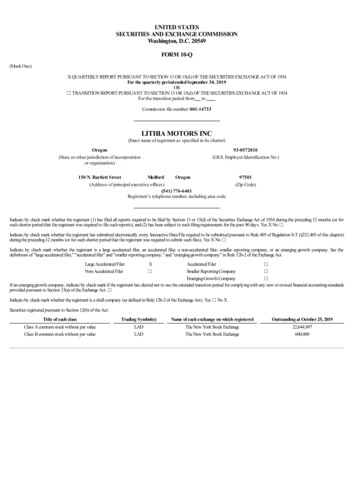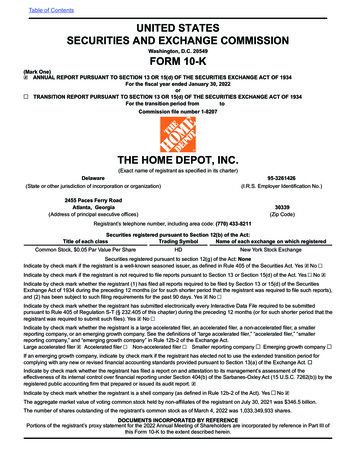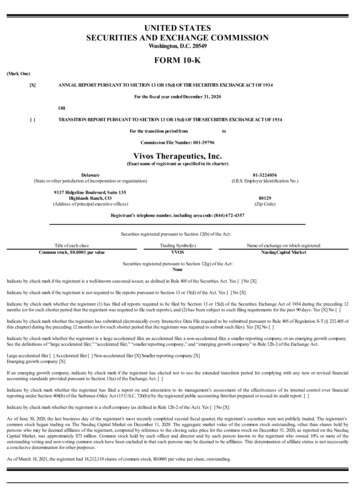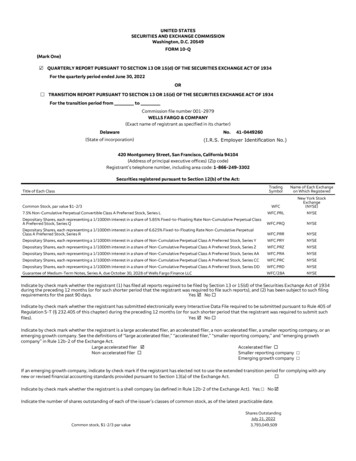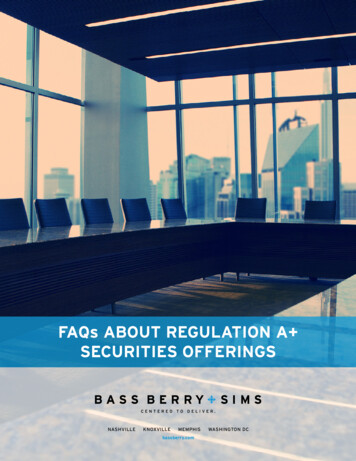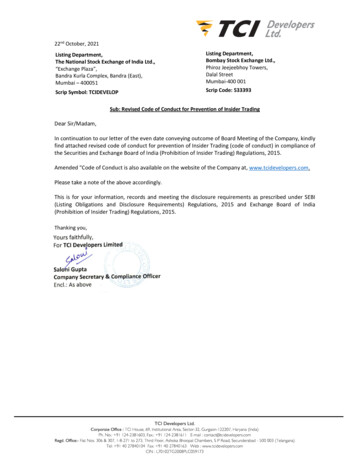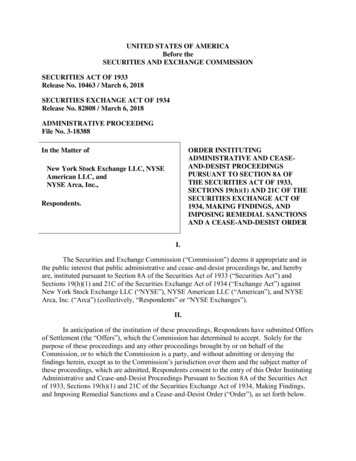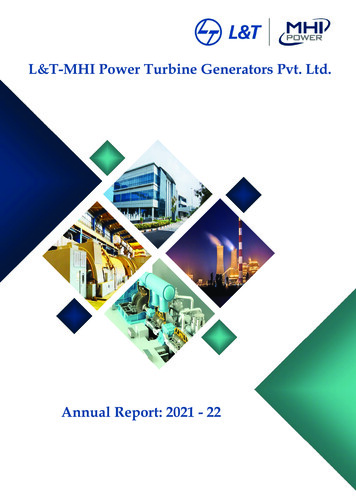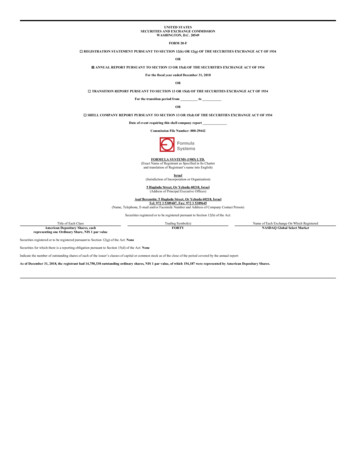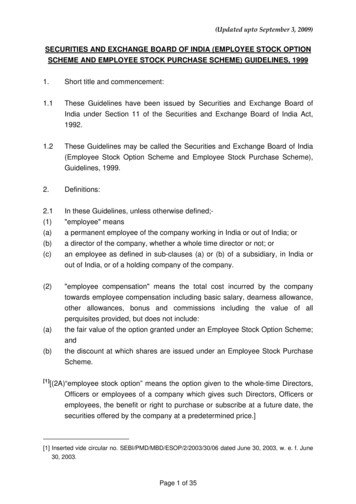
Transcription
(Updated upto September 3, 2009)SECURITIES AND EXCHANGE BOARD OF INDIA (EMPLOYEE STOCK OPTIONSCHEME AND EMPLOYEE STOCK PURCHASE SCHEME) GUIDELINES, 19991.Short title and commencement:1.1These Guidelines have been issued by Securities and Exchange Board ofIndia under Section 11 of the Securities and Exchange Board of India Act,1992.1.2These Guidelines may be called the Securities and Exchange Board of India(Employee Stock Option Scheme and Employee Stock Purchase Scheme),Guidelines, 1999.2.Definitions:2.1(1)(a)(b)(c)In these Guidelines, unless otherwise defined;"employee" meansa permanent employee of the company working in India or out of India; ora director of the company, whether a whole time director or not; oran employee as defined in sub-clauses (a) or (b) of a subsidiary, in India orout of India, or of a holding company of the company.(2)"employee compensation" means the total cost incurred by the companytowards employee compensation including basic salary, dearness allowance,other allowances, bonus and commissions including the value of allperquisites provided, but does not include:the fair value of the option granted under an Employee Stock Option Scheme;andthe discount at which shares are issued under an Employee Stock PurchaseScheme.(a)(b)[1][(2A)“employee stock option” means the option given to the whole-time Directors,Officers or employees of a company which gives such Directors, Officers oremployees, the benefit or right to purchase or subscribe at a future date, thesecurities offered by the company at a predetermined price.][1] Inserted vide circular no. SEBI/PMD/MBD/ESOP/2/2003/30/06 dated June 30, 2003, w. e. f. June30, 2003.Page 1 of 35
(Updated upto September 3, 2009)[2][(3) “employee stock option scheme (ESOS)” means a scheme under which acompany grants employee stock option.](4)"employee stock purchase scheme (ESPS)" means a scheme under whichthe company offers shares to employees as part of a public issue orotherwise.[3][(4a) “ESOS shares” means shares arising out of exercise of options grantedunder ESOS.][4][(4b) “ESPS shares” means shares arising out of grant of shares under ESPS.](5)"exercise" means making of an application by the employee to the companyfor issue of shares against option vested in him in pursuance of the ESOS.(6)"exercise period" means the time period after vesting within which theemployee should exercise his right to apply for shares against the optionvested in him in pursuance of the ESOS.(7)"exercise price" means the price payable by the employee for exercising theoption granted to him in pursuance of ESOS.[5][(7a) “fair value” of an option means the fair value calculated in accordance withSchedule III.](8)"grant" means issue of option to employees under ESOS.[2] Substituted vide circular no. SEBI/PMD/MBD/ESOP/2/2003/30/06 dated June 30, 2003, w. e. f.June 30, 2003. Prior to its substitution, sub-clause (3) read as under:“(3) "employee stock option scheme (ESOS)" means a scheme under which a company grantsoption to employees.”[3] Inserted vide circular no. SEBI/PMD/MBD/ESOP/2/2003/30/06 dated June 30, 2003, w. e. f. June30, 2003.[4] Inserted vide circular no. SEBI/PMD/MBD/ESOP/2/2003/30/06 dated June 30, 2003, w. e. f. June30, 2003.[5] Inserted vide circular no. SEBI/PMD/MBD/ESOP/2/2003/30/06 dated June 30, 2003, w. e. f. June30, 2003.Page 2 of 35
(Updated upto September 3, 2009)(9)"independent director" means a director of the company, not being a wholetime director and who is neither a promoter nor belongs to the promotergroup.[6][(9a) ”intrinsic value” means the excess of the market price of the share [7][ ] underESOS over the exercise price of the option (including up-front payment, ifany).][8][(10) “market price" means the latest available closing price, prior to the date of themeeting of the Board of Directors in which options are granted/ shares areissued, on the stock exchange on which the shares of the company are listed.If the shares are listed on more than one stock exchange, then the stock[6] Inserted vide circular no. SEBI/PMD/MBD/ESOP/2/2003/30/06 dated June 30, 2003, w. e. f. June30, 2003.[7] The words “at the date of grant of the option” omitted vide circular no. SEBI/CFD/DIL/ESOP/3/2004/22/7 dated July 22, 2004, w. e. f. July 22, 2004.[8] Substituted vide circular no. SEBI/CFD/DIL/ESOP/3/2004/22/7 dated July 22, 2004, w. e. f. July22, 2004. Prior to its substitution, sub-clause (10), as substituted vide circular no.SEBI/PMD/MBD/ESOP/ 2/2003/30/06 dated June 30, 2003, w. e. f. June 30, 2003, read as under:“(10) “market price" of a share on a given date means the average of the two weeks high and lowprice of the share preceding the date of grant of option on the stock exchange on which the sharesof the company are listed. If the shares are listed on more than one stock exchange, then the stockexchange where there is highest trading volume during the aforesaid period should beconsidered.”Prior to the abovementioned substitution made vide circular no. SEBI/PMD/MBD/ESOP/2/2003/30/ 06 dated June 30, 2003, sub-clause (10) originally read as under:“(10) "market price" of a share on a given date means the closing price of the shares on that dateon the stock exchange on which the shares of the company are listed.[Explanation: If the shares are listed on more than one stock exchange, but quoted only on onestock exchange on the given date, then the price on that stock exchange should be considered. Ifthe share price is quoted on more than one stock exchange, then the stock exchange where thereis highest trading volume on that date should be considered. If share price is not quoted on thegiven date, then the share price on the next trading day should be considered.]”It is clarified that in respect of periods between June 30, 2003 and July 22, 2004, companies shallbe free to follow the provisions of clause 2.1 (10), either as amended vide the aforesaid circulardated June 30, 2003 or as it existed prior to the amendment made vide the aforesaid circular datedJune 30, 2003.Page 3 of 35
(Updated upto September 3, 2009)exchange where there is highest trading volume on the said date shall beconsidered.”][9][(11) "option grantee “means an employee having right but not an obligation toexercise in pursuance of the ESOS.](12)(a)(b)(c)"promoter" means;the person or persons who are in over-all control of the company;the person or persons who are instrumental in the formation of the companyor programme pursuant to which the shares were offered to the public;the persons or persons named in the offer document as promoter(s). Providedthat a director or officer of the company if they are acting as such only in theirprofessional capacity will not be deemed to be a promoter.Explanation: Where a promoter of a company is a body corporate, thepromoters of that body corporate shall also be deemed to be promoters of thecompany.(13)(a)(b)"promoter group" meansan immediate relative of the promoter (i.e. spouse of that person, or anyparent, brother, sister or child of the person or of the spouse);persons whose shareholding is aggregated for the purpose of disclosing in theoffer document "shareholding of the promoter group".(14)"share" means equity shares and securities convertible into equity shares andshall include American Depository Receipts (ADRs), Global DepositoryReceipts (GDRs) or other depository receipts representing underlying equityshares or securities convertible into equity shares.(15)"vesting" means the process by which the employee is given the right to applyfor shares of the company against the option granted to him in pursuance ofESOS.[9] Substituted vide circular no. SEBI/PMD/MBD/ESOP/2/2003/30/06 dated June 30, 2003, w. e. f.June 30, 2003. Prior to its substitution, sub-clause (11) read as under:“(11) "option" means a right but not an obligation granted to an employee in pursuance of ESOS toapply for shares of the company at a pre-determined price.”Page 4 of 35
(Updated upto September 3, 2009)(16)"vesting period" means the period during which the vesting of the optiongranted to the employee in pursuance of ESOS takes place.2.2All other expressions unless defined herein shall have the same meaning ashave been assigned to them under the Securities and Exchange Board ofIndia Act, 1992 or the Securities Contracts (Regulation) Act, 1956 or theCompanies Act, 1956, SEBI (Disclosure and Investor Protection) Guidelines,or any statutory modification or re-enactment thereof, as the case may be.3.Applicability:3.1These Guidelines shall apply to any company whose shares are listed on anyrecognised stock exchange in India.PART A: ESOS4.Eligibility to participate in ESOS:4.1An employee shall be eligible to participate in ESOS of the company.[10][Explanation: Where such employee is a director nominated by aninstitution as its representative on the Board of Directors of the company –(i)the contract/ agreement entered into between the institution nominatingits employee as the director of a company and the director soappointed shall, inter-alia, specify the following:(a)whether options granted by the company under its ESOS can beaccepted by the said employee in his capacity as director of thecompany;(b)that options, if granted to the director, shall not be renounced infavour of the nominating institution; and(c)the conditions subject to which fees, commissions, ESOSs,other incentives, etc. can be accepted by the director from thecompany.(ii)the institution nominating its employee as a director of a company shallfile a copy of the contract/ agreement with the said company, which[10] Inserted vide circular no. SEBI/CFD/DIL/ESOP/4/2008/04/08 dated August 4, 2008, w. e. f.August 4, 2008.Page 5 of 35
(Updated upto September 3, 2009)(iiii)shall, in turn, file the copy with all the stock exchanges on which itsshares are listed.the director so appointed shall furnish a copy of the contract/agreement at the first Board meeting of the company attended by himafter his nomination.]4.2An employee who is a promoter or belongs to the promoter group shall not beeligible to participate in the ESOS.4.3A director who either by himself or through his relative or through any bodycorporate, directly or indirectly holds more than 10% of the outstanding equityshares of the company shall not be eligible to participate in the ESOS.5.Compensation Committee:[11][5.1 No ESOS shall be offered unless the disclosures, as specified in Schedule IV,are made by the company to the prospective option grantees and thecompany constitutes a Compensation Committee for administration andsuperintendence of the ESOS.]5.2The Compensation Committee shall be a Committee of the Board of directorsconsisting of a majority of independent directors.5.3The Compensation Committee shall, inter alia, formulate the detailed termsand conditions of the ESOS including;the quantum of option to be granted under an ESOS per employee and inaggregate.the conditions under which option vested in employees may lapse in case oftermination of employment for misconduct;the exercise period within which the employee should exercise the option andthat option would lapse on failure to exercise the option within the exerciseperiod;the specified time period within which the employee shall exercise the vestedoptions in the event of termination or resignation of an employee.(a)(b)(c)(d)[11] Substituted vide circular no. SEBI/PMD/MBD/ESOP/2/2003/30/06 dated June 30, 2003, for alloptions granted on or after June 30, 2003. Prior to its substitution, clause 5.1 read as under:“5.1 No ESOS shall be offered unless the company constitutes a Compensation Committee foradministration and superintendence of the ESOS.”Page 6 of 35
(Updated upto September 3, 2009)(e)the right of an employee to exercise all the options vested in him at one timeor at various points of time within the exercise period;[12][(f) the procedure for making a fair and reasonable adjustment to the number ofoptions and to the exercise price in case of corporate actions such as rightsissues, bonus issues ,merger, sale of division and others. In this regardfollowing shall be taken into consideration by the compensation committee:(i)the number and the price of ESOS shall be adjusted in a manner such thattotal value of the ESOS remains the same after the corporate action(ii)for this purpose global best practices in this area including the proceduresfollowed by the derivative markets in India and abroad shall be considered.(iii)the vesting period and the life of the options shall be left unaltered as far aspossible to protect the rights of the option holders.](g)the grant, vest and exercise of option in case of employees who are on longleave; and(h)the procedure for cashless exercise of options.5.4The Compensation Committee shall frame suitable policies and systems toensure that there is no violation of;Securities and Exchange Board of India (Insider Trading) Regulations, 1992;andSecurities and Exchange Board of India (Prohibition of Fraudulent and UnfairTrade Practices relating to the Securities Market) Regulations, 1995, by anyemployee.(a)(b)6.Shareholder approval:6.1No ESOS can be offered to employees of a company unless the shareholdersof the company approve ESOS by passing a special resolution in the generalmeeting.6.2The explanatory statement to the notice and the resolution proposed to bepassed in general meeting for ESOS shall, inter alia, contain the followinginformation:the total number of options to be granted;(a)[12] Substituted vide circular no. SEBI/PMD/MBD/ESOP/2/2003/30/06 dated June 30, 2003, for allcorporate actions on or after June 30, 2003. Prior to its substitution, sub-clause (f) read as under:“(f) the procedure for making a fair and reasonable adjustment to the number of options and to theexercise price in case of rights issues, bonus issues and other corporate actions;”Page 7 of 35
(Updated upto September 3, 2009)(b)(c)(d)identification of classes of employees entitled to participate in the ESOS;requirements of vesting and period of vesting;maximum period (subject to clause 9.1) within which the options shall bevested;(e)exercise price or pricing formula;(f)exercise period and process of exercise;(g)the appraisal process for determining the eligibility of employees to theESOS;(h)maximum number of options to be issued per employee and in aggregate;(i)a statement to the effect that the company shall conform to the accountingpolicies specified in clause 13.1;[13][(j) the method which the company shall use to value its options whether fairvalue or intrinsic value;(k)the following statement:‘In case the company calculates the employee compensation cost using theintrinsic value of the stock options, the difference between the employeecompensation cost so computed and the employee compensation cost thatshall have been recognized if it had used the fair value of the options, shall bedisclosed in the Directors report and also the impact of this difference onprofits and on EPS of the company shall also be disclosed in the Directors’report.’]6.3(a)(b)Approval of shareholders by way of separate resolution in the general meetingshall be obtained by the company in case of;grant of option to employees of subsidiary or holding company and,grant of option to identified employees, during any one year, equal to orexceeding 1% of the issued capital (excluding outstanding warrants andconversions) of the company at the time of grant of option.7.Variation of terms of ESOS:7.1The company shall not vary the terms of the ESOS in any manner, which maybe detrimental to the interests of the employees.7.2The company may by special resolution in a general meeting vary the termsof ESOS offered pursuant to an earlier resolution of a general body but not yet[13] Inserted vide circular no. SEBI/PMD/MBD/ESOP/2/2003/30/06 dated June 30, 2003, for allnotices of general meetings sent on or after June 30, 2003.Page 8 of 35
(Updated upto September 3, 2009)exercised by the employee provided such variation is not prejudicial to theinterests of the option holders.7.3The provisions of clause 6.3 shall apply to such variation of terms as they doto the original grant of option.7.4The notice for passing special resolution for variation of terms of ESOS shalldisclose full details of the variation, the rationale therefor, and the details ofthe employees who are beneficiary of such variation.[14][7.5 A company may reprice [15][the options which are not exercised, whether ornot they have been vested] if ESOSs were rendered unattractive due to fallin the price of the shares in the market.Provided that the company ensures that such repricing shall not bedetrimental to the interest of employees and approval of shareholders inGeneral Meeting has been obtained for such repricing.]8.Pricing:8.1The companies granting option to its employees pursuant to ESOS will havethe freedom to determine the exercise price subject to conforming to theaccounting policies specified in clause 13.1.[16][Provided that in case the company calculates the employee compensationcost using the intrinsic value of the stock options, the difference between theemployee compensation cost so computed and the employee compensationcost that shall have been recognized if it had used the fair value of theoptions, shall be disclosed in the Directors report and also the impact of thisdifference on profits and on Earning Per Share of the company shall also bedisclosed in the Directors’ report.][14] Inserted vide circular no. SEBI/PMD/MBD/ESOP/2/2003/30/06 dated June 30, 2003, for anyrepricing of options done on or after June 30, 2003.[15] Substituted for “the options which are not exercised”, vide circular no. SEBI/CFD/DIL/ESOP/3/2004/22/7 dated July 22, 2004, for any repricing of options done on or after June 30, 2003.[16] Inserted vide circular no. SEBI/PMD/MBD/ESOP/2/2003/30/06 dated June 30, 2003, for alloptions granted on or after June 30, 2003.Page 9 of 35
(Updated upto September 3, 2009)9.Lock-in period and rights of the option-holder:9.1There shall be a minimum period of one year between the grant of optionsand vesting of option.[17][Provided that in a case where options are granted by a company under anESOS in lieu of options held by the same person under an ESOS in anothercompany which has merged or amalgamated with the first mentionedcompany, the period during which the options granted by the transferorcompany were held by him shall be adjusted against the minimum vestingperiod required under this clause.]9.2The company shall have the freedom to specify the lock-in period for theshares issued pursuant to exercise of option.9.3The employee shall not have right to receive any dividend or to vote or in anymanner enjoy the benefits of a shareholder in respect of option granted tohim, till shares are issued on exercise of option.10.Consequence of failure to exercise option:10.1(a)The amount payable by the employee, if any, at the time of grant of option;may be forfeited by the company if the option is not exercised by theemployee within the exercise period; orthe amount may be refunded to the employee if the option are not vested dueto non-fulfillment of condition relating to vesting of option as per the ESOS.(b)11.Non transferability of option:11.1Option granted to an employee shall not be transferable to any person.11.2(a) No person other than the employee to whom the option is granted shall beentitled to exercise the option.[17] Inserted vide circular no. SEBI/CFD/DIL/ESOP/3/2004/22/7 dated July 22, 2004, for all mergersor amalgamations whose effective date is on or after July 22, 2004.Page 10 of 35
(Updated upto September 3, 2009)(b)Under the cashless system of exercise, the company may itself fund or permitthe empanelled stock brokers to fund the payment of exercise price whichshall be adjusted against the sale proceeds of some or all the shares, subjectto the provision of the Companies Act.11.3The option granted to the employee shall not be pledged, hypothecated,mortgaged or otherwise alienated in any other manner.11.4In the event of the death of employee while in employment, all the optiongranted to him till such date shall vest in the legal heirs or nominees of thedeceased employee.11.5In case the employee suffers a permanent incapacity while in employment, allthe option granted to him as on the date of permanent incapacitation, shallvest in him on that day.11.6In the event of resignation or termination of the employee, all options notvested as on that day shall expire. However, the employee shall, subject tothe provision of clause 5.3 (b) shall be entitled to retain all the vested options.[18][11.7 The options granted to a director, who is an employee of an institution andhas been nominated by the said institution, shall not be renounced in favourof the institution nominating him.]12.Disclosure in the Directors' Report:12.1(a)(b)(c)(d)(e)(f)(g)The Board of Directors, shall, inter alia, disclose either in the Directors’ Reportor in the annexure to the Directors’ Report, the following details of the ESOS:options granted;the pricing formula;options vested;options exercised;the total number of shares arising as a result of exercise of option;options lapsed;variation of terms of options;(h)money realised by exercise of options;[18] Inserted vide circular no. SEBI/CFD/DIL/ESOP/4/2008/04/08 dated August 4, 2008, w. e. f.August 4, 2008.Page 11 of 35
(Updated upto September 3, 2009)(i)(j)(i)(ii)total number of options in force;employee wise details of options granted to;senior managerial personnel;any other employee who receives a grant in any one year of option amountingto 5% or more of option granted during that year.(iii)identified employees who were granted option, during any one year, equal toor exceeding 1% of the issued capital (excluding outstanding warrants andconversions) of the company at the time of grant;(k)diluted Earnings Per Share (EPS) pursuant to issue of shares on exercise ofoption calculated in accordance with [19][Accounting Standard (AS) 20‘Earnings Per Share’].[20][(l) Where the company has calculated the employee compensation cost usingthe intrinsic value of the stock options, the difference between the employeecompensation cost so computed and the employee compensation cost thatshall have been recognized if it had used the fair value of the options, shall bedisclosed. The impact of this difference on profits and on EPS of the companyshall also be erage exercise prices and weighted-average fair values ofoptions shall be disclosed separately for options whose exercise price eitherequals or exceeds or is less than the market price of the stock [21][ ].A description of the method and significant assumptions used during the yearto estimate the fair values of options, including the following weighted-averageinformation:risk-free interest rate,expected life,expected volatility,expected dividends, andthe price of the underlying share in market at the time of option grant.]Substituted for “International Accounting Standard (IAS) 33” videSEBI/CFD/DIL/ESOP/ 3/2004/22/7 dated July 22, 2004, w. e. f. July 22, 2004.circularno.[20] Inserted vide circular no. SEBI/PMD/MBD/ESOP/2/2003/30/06 dated June 30, 2003. Sub- clause(l) shall come into effect for all options granted on or after June 30, 2003 while sub-clauses (m)and (n) shall come into effect from June 30, 2003.[21] The words “on the grant date” omitted vide circular no. SEBI/CFD/DIL/ESOP/3/2004/22/7 datedJuly 22, 2004, w. e. f. July 22, 2004.Page 12 of 35
(Updated upto September 3, 2009)[22][12.2 Until all options granted in the three years prior to the IPO have beenexercised or have lapsed, disclosures shall be made either in the Directors’Report or in an Annexure thereto of the information specified in clause 12.1 inrespect of such options also.12.3Until all options granted in the three years prior to the IPO have beenexercised or have lapsed, disclosure shall be made either in the Directors’Report or in an Annexure thereto of the impact on the profits and on the EPSof the company if the company had followed the accounting policies specifiedin clause 13 in respect of such options.]13.Accounting Policies:13.1Every company that has passed a resolution for an ESOS under clause 6.1 ofthese guidelines shall comply with the accounting policies specified inSchedule I.[23]13.2 [Deleted]14.Certificate from Auditors:14.1In the case of every company that has passed a resolution for an ESOS underclause 6.1 of these guidelines, the Board of Directors shall at each annualgeneral meeting place before the shareholders a certificate from the auditorsof the company that the scheme has been implemented in accordance withthese guidelines and in accordance with the resolution of the company in thegeneral meeting.[22] Inserted vide circular no. SEBI/CFD/DIL/ESOP/3/2004/22/7 dated July 22, 2004, for all Directors’Reports signed on or after July 22, 2004.[23] Omitted clause 13.2 vide circular no. SEBI/CFD/DIL/ESOP/4/2008/04/08 dated August 4, 2008,w. e. f. August 4, 2008. Prior to its omission, clause 13.2, as inserted vide circular no.SEBI/PMD/MBD/ESOP/2/2003/30/06 dated June 30, 2003, for all accounting periodscommencing on or after June 30, 2003, read as under:“13.2 Where a scheme provides for graded vesting, the vesting period shall be determinedseparately for each portion of the option and shall be accounted for accordingly.”Page 13 of 35
(Updated upto September 3, 2009)[24]15. [Deleted][25]15.1 [Deleted][26]15.2 [Deleted][27]15.3 [Deleted][24] Omitted clause 15 vide circular no. SEBI/CFD/DIL/ESOP/5/2009/03/09 dated September 3, 2009.Prior to its omission, clause 15 read as under:“15. Options outstanding at Public Issue:”[25] Omitted clause 15.1 vide circular no. SEBI/CFD/DIL/ESOP/5/2009/03/09 dated September 3,2009. Prior to its omission, clause 15.1 read as under:“15.1 The provisions of the Securities and Exchange Board of India (Disclosure and InvestorProtection) Guidelines prohibiting initial public offering by companies having outstandingwarrants and financial instruments shall not be applicable in case of outstanding option grantedto employees in pursuance of ESOS.”[26] Omitted clause 15.2 vide circular no. SEBI/CFD/DIL/ESOP/5/2009/03/09 dated September 3,2009. Prior to its omission, clause 15.2 read as under:“15.2 If any option is outstanding at the time of an initial public offering by a company, thepromoters' contribution shall be calculated with reference to the enlarged capital which wouldarise on exercise of all vested options.”[27] Omitted clause 15.3 vide circular no. SEBI/CFD/DIL/ESOP/5/2009/03/09 dated September 3,2009. Prior to its omission, clause 15.3 was substituted vide circular no.SEBI/CFD/DIL/ESOP/3/2004/22/7 dated July 22, 2004, for all initial public offer documents filedon or after July 22, 2004 and read as under:“15.3 If any options granted to employees in pursuance of pre-IPO ESOS are outstanding at thetime of IPO, the IPO document of the company shall disclose all the information specified inclause 12.1 and also the following information:(a) The impact on the profits and on the EPS of the last three years if the company had followedthe accounting policies specified in clause 13 in respect of options granted in the last threeyears.(b) The intention of the holders of shares allotted on exercise of option granted under ESOS orallotted under ESPS, to sell their shares within three (3) months after the date of listing ofshares in such IPO (aggregate number of shares intended to be sold by option holders), ifany, has to be disclosed. In case of ESOS the same shall be disclosed regardless of whetherthe shares arise out of options exercised before or after the IPO.(c) Specific disclosures about the intention to sell shares arising out of ESOS or allotted underESPS within three (3) months after the date of listing, by directors, senior managerialpersonnel and employees having ESOS or ESPS shares amounting to more than 1% of theissued capital (excluding outstanding warrants and conversions), which inter-alia shall includePage 14 of 35
(Updated upto September 3, 2009)PART B: ESPS15.Eligibility to participate in ESPS:16.1An employee shall be eligible to participate in the ESPS.16.2An employee who is a promoter or belongs to the promoter group shall not beeligible to participate in the ESPS.16.3A director who either by himself or through his relatives or through any bodycorporate, directly or indirectly holds more than 10% of the outstanding equityshares of the company shall not be eligible to participate in the ESPS.16.Shareholder Approval:17.1No ESPS shall be offered to employees of the company unless theshareholders of the company approve ESPS by passing special resolution inthe meeting of the general body of the shareholders.17.2(a)The explanatory statement to the notice shall specify:the price of the shares and also the number of shares to be offered to eachemployee.(b)the appraisal process for determining the eligibility of employee for ESPS.[28][(c) Total number of shares to be [29][issued].]name, designation and quantum of ESOS or ESPS shares and quantum they intend to sellwithin three (3) months.(d) A disclosure in line with the clause 12 and 19 of these guidelines, regarding all theoptions/shares issued in last three (3) years (separately for each year) and on a cumulativebasis for all the options/shares issued prior to date of the prospectus.”Prior to the abovementioned substitution, clause 15.3 read as under:“15.3 If any options granted to employees in pursuance of ESOS are outstanding at the time ofinitial public offering, the offer document of the company shall disclose all the information specifiedin clause 12.1.”[28] Inserted vide circular no. SEBI/PMD/MBD/ESOP/2/2003/30/06 dated June 30, 2003, for allnotices of general meetings sent on or after June 30, 2003.Page 15 of 35
(Updated upto
[2][(3) "employee stock option scheme (ESOS)" means a scheme under which a company grants employee stock option.] (4) "employee stock purchase scheme (ESPS)" means a scheme under which the company offers shares to employees as part of a public issue or otherwise. [3][(4a) "ESOS shares" means shares arising out of exercise of options granted

